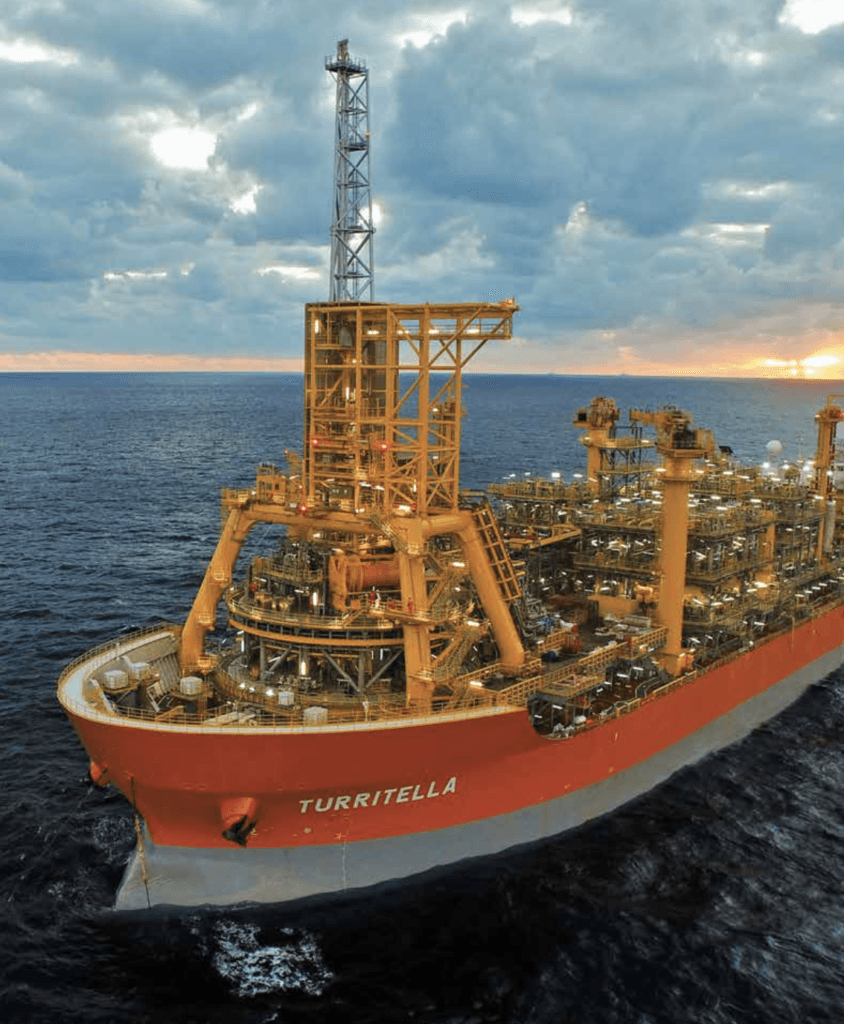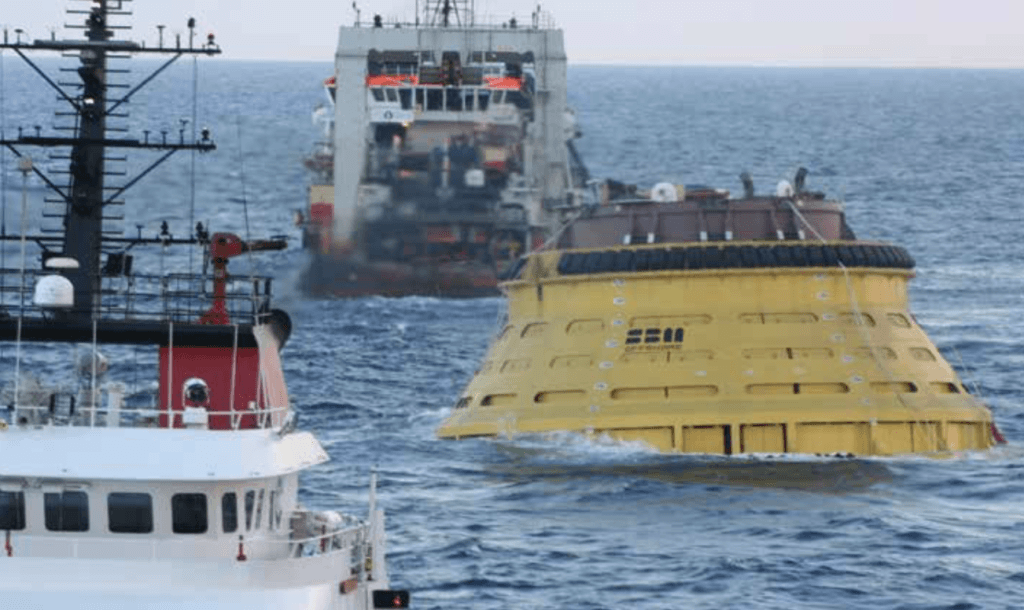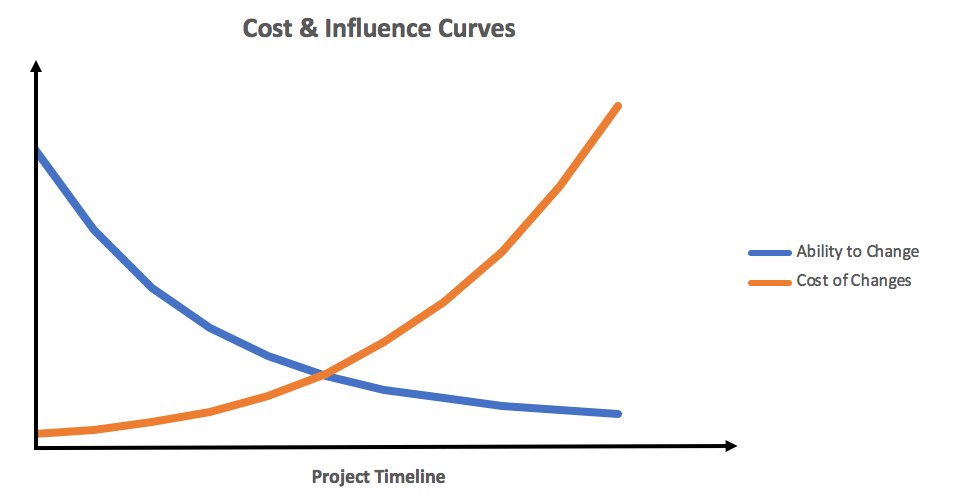Using 3D Printing to Break the Iron Triangle

The days of easy oil are over. No longer can a wildcatter don a hardhat, set up a derrick, and strike it rich in Oklahoma. Operators must now use 3D printing to unlock hard-to-reach resources.
Between now and 2040, conventional oil production will decline from 65 million to 60 million barrels per day [1].
But, the global middle class is growing. The world GDP is likely to double by 2030 and energy demand will increase by 25% by 2040. While 10% of that demand will be met by renewable and nuclear power sources, hard-to-reach oil will bridge the gap between declining conventional plays and renewable alternatives [1].
However, hard-to-reach oil comes at a price. Drilling in deep water requires elaborate facilities designed with incredible civil, architectural, and process engineering. Companies will need to reduce capital expenditures and execute rigorous project management strategies to ensure that the NPV of the project remains economic.
With the Stones project off the coast of Louisiana, Shell was able to do just that [4].
The Iron Triangle and the Cost & Influence Curves
The tradeoff between cost, schedule, and quality of construction has been studied extensively in project management [2]. This tradeoff, often referred to as the iron triangle, implies that an increase in one dimension must come at the sacrifice of another [3]. With long lead times for equipment and expensive day-rates for contractors, project managers are often forced to balance time, budget, and reliability.
As the project progresses, the effects of the iron triangle become increasingly visible. Due to the compounding nature of oil and gas construction – as equipment is secured and pipes are routed – the influence of the project manager decreases over time. Small changes become increasingly costly, and the cost & influence curves begin to take shape.
Fig 1. Cost and influence curves of a typical capital project
So how do project managers ensure that changes are restricted to the early stages of project development? Shell is using 3D printing to scrutinize engineering design early in the project timeline [4].
Shell’s Stones Project
Shell’s Stones project is the world’s deepest subsea development [5]. Operating in 9,500 feet of water in the Gulf of Mexico, the facility can detach an 82 foot, 1250 metric ton buoy to produce oil and gas during inclement weather [4].

Fig 2. The FPSO facility used in the Stones project [4]
Under normal situations, building a computer model of the buoy would take months. But, with the use of 3D printing, the model was able to be completed in just 4 weeks [4].
The four-story tall buoy contained over 1000 blocks of interlocked foam pieces. Typically, engineers would have to rely on drawings to understand how the pieces fit together. But with the printable model, engineers from all different functions could inspect and critique the miniature design in their own hands. By building the buoy at their desks, engineers and project managers got it right the first time [4].
But Shell isn’t stopping there. In the near term, Shell is supplementing its research with 3D printing experiments at the Shell Technology Center in Amsterdam. In addition to improving front end engineering design (FEED) of new projects, the company anticipates using 3D printing to manufacture devices that improve current operations. Such instruments will improve facility monitoring, thereby increasing equipment reliability and enhancing the ROI of its operating assets [6].
As the advancement of technology continues, Shell is expanding the scope of 3D printing to the construction process itself. By partnering with companies like Contour Crafting, Shell will eventually automate the process of pouring concrete. Automating construction will improve safety by eliminating high risk, human-centered activities [7].

Fig 3. The buoy deployed at sea [4]
While the 3D printing era is underway, Shell has not fully realized printing potential. Shell should be using its 3D printing capabilities to train core competencies and manage facilities changes. Project managers should use 3D models in the field to communicate execution strategy. Existing facilities should retain 3D models for safety hazard and operability studies (HAZOPs). All engineers should have access to 3D printers to visualize their ideas and “fax” learnings to other sites.
When 3D printing becomes used for larger scale activities, the company should consider printing its own piping. Enabling piping fabrication at the site reduces the dependency on third party manufacturers and shortens lead time. As energy facilities become more modularized, projects can be completely printed at the fabrication yard. In other words, a one stop shop for construction.
But will the iron triangle ever fully disappear? While 3D printing may improve schedule performance, will project cost or quality suffer if materials are printed on site? Will 3D printed materials eventually exhibit economies of scale?
By lessening the impact of the iron triangle, energy will become more accessible to the world, improving the lives of billions around the globe. In a world where resources are becoming ever more costly to develop, innovation is the only solution.
(787 words)
Bibliography:
[1] “2018 Outlook For Energy: A View To 2040”. 2018. Cdn.Exxonmobil.Com. https://cdn.exxonmobil.com/~/media/global/files/outlook-for-energy/2018/2018-outlook-for-energy.pdf.
[2] Goodwin, B. L. (1990). The development and use of progress curves. American Association of Cost Engineers.Transactions of the American Association of Cost Engineers, , 52. Retrieved from http://search.proquest.com.ezp-prod1.hul.harvard.edu/docview/208193531?accountid=11311
[3] Pollack, J., Helm, J., & Adler, D. (2018). What is the iron triangle, and how has it changed? International Journal of Managing Projects in Business, 11(2), 527-547. doi:http://dx.doi.org.ezp-prod1.hul.harvard.edu/10.1108/IJMPB-09-2017-0107
[4] “The Stones Development”. 2018. https://www.ogj.com/content/dam/offshore/site-images/stones_development.pdf.
[5] “Stones”. 2018. Shell.Com. https://www.shell.com/about-us/major-projects/stones.html.
[6] “3D Printing”. 2018. Shell.Com. https://www.shell.com/inside-energy/3d-printing.html.
[7] “Grand Designs: How 3D Printing Could Change Our World”. 2018. Shell.Com. https://www.shell.com/inside-energy/how-3d-printing-is-changing-the-world.html.
[Featured Image] “Verification Of Subsea Facilities – DNV GL”. 2018. DNV GL. https://www.dnvgl.com/services/verification-of-subsea-facilities-3361.




Mark, thanks for a fascinating look into the high tech in the offshore sector. The scale and extremely demanding nature of the operational requirements for equipment operating in the deepwater extraction segment is always impressive. I’m curious if 3D printing also has potential to reduce inventories for spare parts and make fabrication of parts possible in remote environments. In 2014, the U.S. Navy began experimenting with 3D printers at aviation heavy maintenance depots to fabricate parts themselves to speed the repair of equipment. Would it be beneficial for installations in austere environments or ships underway to have the ability to fabricate parts themselves to make them less dependent on supply from shore? Or is the cost savings from reduced inventory and reduced down time too small to make the CAPEX in rolling out specialized 3D printing equipment worth the investment? Only time will tell. Nice work!
This is super interesting! What really strikes me about the use of 3D printing for large, time intensive and capital intensive projects like these is that the 3D printing enables iteration that wouldn’t otherwise be feasible. It reminds me a lot of the paradox of the marshmallow challenge from FIELD – previously, there was a lot of up front resources devoted to creating the project without much room for iteration and prototyping, whereas now they are able to do so before making the investment. Would love to know how this could be applied to other industries as well!
Thanks Mark for sharing this innovative solution to hard-to-reach oil and the 3D prototyping that assisted the development! Very fascinating to learn about the new advances in technology that are allowing economic recovery of difficult to access oil resources. I think the question of whether 3D printed materials will achieve economies of scale in the oil and gas industry is an interesting one given the “finite” nature of the industry (for lack of a better term). Peak oil demand is expected to occur in the next two to three decades (or as soon as the 2020s if countries adhered to the terms of the Paris climate accord) and at some point countries and companies alike will need to commit to a significant decrease in dependence on fossil fuels in order to mitigate the impact of climate change. Will 3D printing reach economies of scale prior to this point, or are companies like Shell better suited to investing in renewable energy and cleantech to get capitalize on this trend?
Mark – you adeptly summarised how 3D printing helped Shell overcome the design challenges associated with developing this pioneering technology. I can clearly see how 3D printing helped engineers visualise the solution they developed, find errors early on and thus reduce the design lead time and costs associated. I think you posed a good question: to what extent can 3D printing be scaled? For example, I have my doubts as to applicability of 3D printing to tasks such as pipework. I can definitely see how robots may be used to weld pipe segments together to create unique pipe segments, but question whether it would be efficient to 3D print such a pipe segment given the majority of that segment is of uniform cylindrical shape. If this technology evolves with time to handle such repetitive tasks efficiently, this would revolutionise the construction industry, but I still believe the iron triangle will remain. No matter your level of technological advancement, a project manager will always have a trade-off between cost, schedule and quality. Technology would just raise the bar as to what is considered acceptable standards.
Thank you for your research into how technology can revolutionize an industry that has been in existence for over a century. I do concur with your view that 3D printing can enable engineers and companies to more adeptly plan and scrutinize projects by having a physical miniature design of the platform that they intend to build. Doing so would help to reduce cost and enhance innovation as workers are able to see how the construction or design of a particular feature on the facility impacts others. Oftentimes, oil and gas project engineers are not able to foresee how a particular design can hinder efficiency of production until it’s too late.
However, I do not believe that 3D printed equipment such as pipes can be used in the actual construction of a project. This is because there are so many safety standards and regulatory specifications that cannot yet be captured by 3D printing. Also, if a pipe were to burst leading to a leakage, how would it be fixed? Would an entirely new pipe have to be built?
The significance of the iron triangle cannot be understated as companies need to find innovative ways to reduce costs, especially when exploring unconventional basins or hard to reach resources. I assume that there could be a sweet spot in which we can make effieciences or enhancements in one direction without having to make sacrifices in the other. I believe that leveraging technology will be the best way to go about achieving this.
Mark,
Thanks for opening my eyes to how shell is already utilising additive manufacturing!
It’s fascinating to me to understand how they are using 3D printing to make prototypes to make it easier for the engineers to understand how what they are working on fits with other parts of the project and see the model of their project in real life. I have heard from many of my friends who are O&G engineerers how frustrating and difficult it can be to work on a very small part of a larger product and not be able to see how it actually fits in with the larger project. However, I can’t help to question how helpful it actually is for the overall process to have a miniature model of construction projects that will ultimately turn into some of the worlds most massive and impressive construction and drilling equipment. Will the miniature models really help the engineers understand the load balancing, structural stability and unforeseen issues for the real construction in a completely different material? I am not an engineer and admit that I am really not qualified to comment, but I would love to hear your view on whether this is really a “nice to have” for the engineers or something that makes a substantial impact on their large scale projects.
Thanks again for the interesting paper!
Thanks for the article Mark. Very interesting read. Although I am a great believer in 3D printing and it’s potential to revolutionize the construction industry, I have some doubts as to whether 3D printing could really help remove the “iron triangle” and improve project schedules in the short to medium term. Project schedule is typically defined by the project’s critical path, and for a mega-project such as Shell Stone or Shell Prelude, the critical path is defined by the procurement long lead item delivery. In the case of Shell Prelude and other Floating LNG projects, the long lead item for the whole project is the gas turbine generators (around 20-24 months). Therefore, unless the equipment suppliers commit to a significantly faster delivery schedule, significant improvements in project schedule will be tough to achieve. One could argue that perhaps 3D printing will be adopted by equipment OEM as well, thereby improving delivery times. This of course could be true, and I certainly hope that this will happen. In conclusion, I believe that in order for schedule optimization to be realized via introduction of 3D printing technology in large capital projects in the O&G industry, the project management value chain will have to improve its schedule performance. Congratulations on your very well written article!
This essay brings other innovations to mind such as the lightbulb which cost $850,000 to develop and a worker’s day wage to buy. It took 1,200 attempts to get to the perfect light bulb but over time and process improvement we now enjoy cheap lighting in our homes and streets. As you pointed out, one key benefit of 3D printing that we are already seeing is the acceleration of product development. This alone might not eliminate the iron triangle but it probably goes a long way to reducing it. I believe the only way to take it further would be to transform the way in which items are manufactured in the industry. Shifting the focus from designing large bulky parts into smaller parts that are used to build up the whole would not only make 3D printing doable but also be able to increase the rate of defect detection. Through this, the oil and gas industry can manufacture, stock and replace these parts as needed and as the oil and gas industry evolves, replace certain parts with those that have improved designs. This would have both the benefit of having the ability to make bespoke solutions for the industry as well as addressing challenges operators face in minimizing unscheduled downtime by maintaining large inventories of critical spare parts. Traditionally, it has been more cost-effective to overstock parts than to deal with extended downtime. Additive manufacturing can optimize asset maintenance by reducing warehouse stocks through on-demand printing and I believe the attendant savings have more impact given the historical volatility of oil prices.
It’s incredible to see how revolutionary 3d printing has been for Shell and the industry as a whole. How expensive would it be to roll out these 3d printers on a company-wide scale, and how intensive is the training necessary to program and operate these? If it’s relatively easy to learn, why hasn’t everyone started adopting this into their project management processes? I’m also interested in the integrity of the material used in 3d printing. I can see that it’s great for printing out prototypes but can we take it to the next level and 3d print actual parts that get used? I’m also interested to see how much this spreads throughout other related industries with high capital costs like construction.
Fascinating. I have to think that the 3D printing approach will likely lead to quality issues, or will at least be limited to use in certain activities due to potential engineering limitations of the finished products; this could be my bias to thinking about 3D printing as limited to plastic, but it seems to me as a layman that either raw materials or methods used in 3D printed tools would reduce tolerances compared to conventional tools, such as pipe.
Side note – does Exxon know you’re hyping the competition? 😉